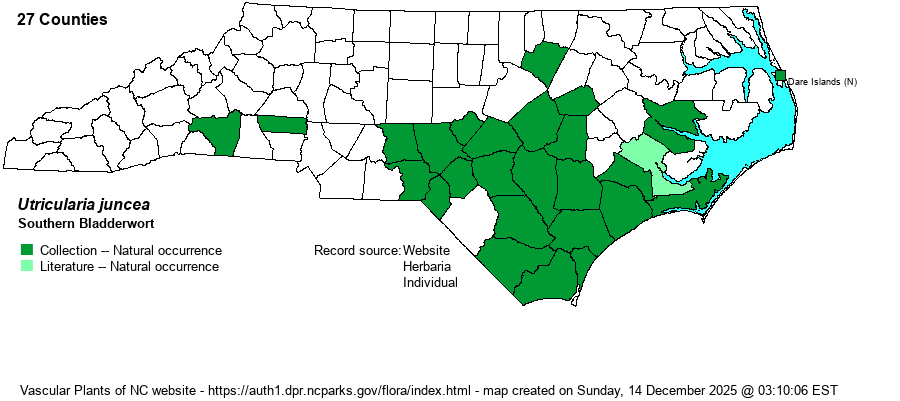| Author | Vahl | |
| Distribution | Occurs nearly throughout the southern 45-50% of the Coastal Plain, including the Sandhills region. The northernmost record is for the Dare County north coast, Beaufort, and Wilson counties. However, there are scattered records for the southeastern third of the Piedmont, west to Franklin, Lincoln, and Rutherford counties.
This is a Southern species found from coastal NY south to southern FL, and west to southeastern OK and central TX. There are only a few scattered records for the Piedmont province.
| |
| Abundance | Infrequent to fairly common from Carteret County west to Johnston County and south to SC. Rare in the north-central part of that province and very rare in the Piedmont. | |
| Habitat | This bladderwort needs less water in which to grow than most others, being found in seepage slopes, streamhead ecotones, borrow ponds and scrapes, shallow pond margins (such as limesink ponds and clay-based bays), and occasionally in ditches. It is not as particular in its habitats as is the similar U. cornuta. |
| Phenology | Blooms from July to September, generally a few weeks later than U. cornuta where both occur together. | |
| Identification | As with U. cornuta, the identification is from the stem and flowers and not the small leaves at the base of the flowering stem. The stem grows to about 7-8 inches tall, is purplish-green, and contains numerous bright yellow flowers arranged rather scattered up and down the upper part of the stalk. Each flower is about 1/2-inch long/across, with a long downward curving spur that seems to "tilt" the flower somewhat upward. Only U. cornuta has a similar flower, but that species has larger flowers that may trend to a more golden color (but can also be bright yellow), a taller stem to about 10 inches tall, a stem that is yellow-green, and the flowers growing closer together and not as scattered (as in U. juncea). Fortunately for the biologist, he or she can often run into U. juncea when looking around the margins of pools and pond margins, such as margins of limesink ponds and clay-based Carolina bays. | |
| Taxonomic Comments | None
| |
| Other Common Name(s) | None | |
| State Rank | S3 [S3S4] | |
| Global Rank | G5 | |
| State Status | | |
| US Status | | |
| USACE-agcp | OBL link |
| USACE-emp | OBL link |

